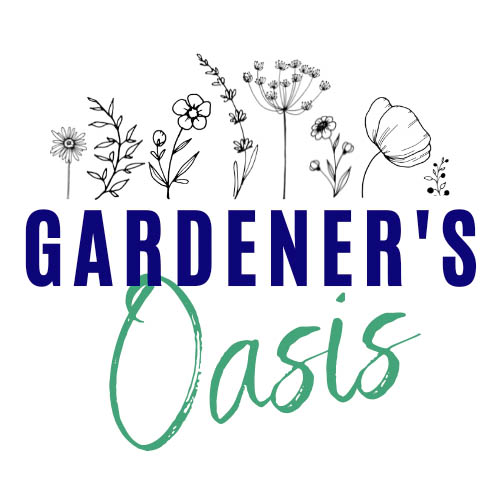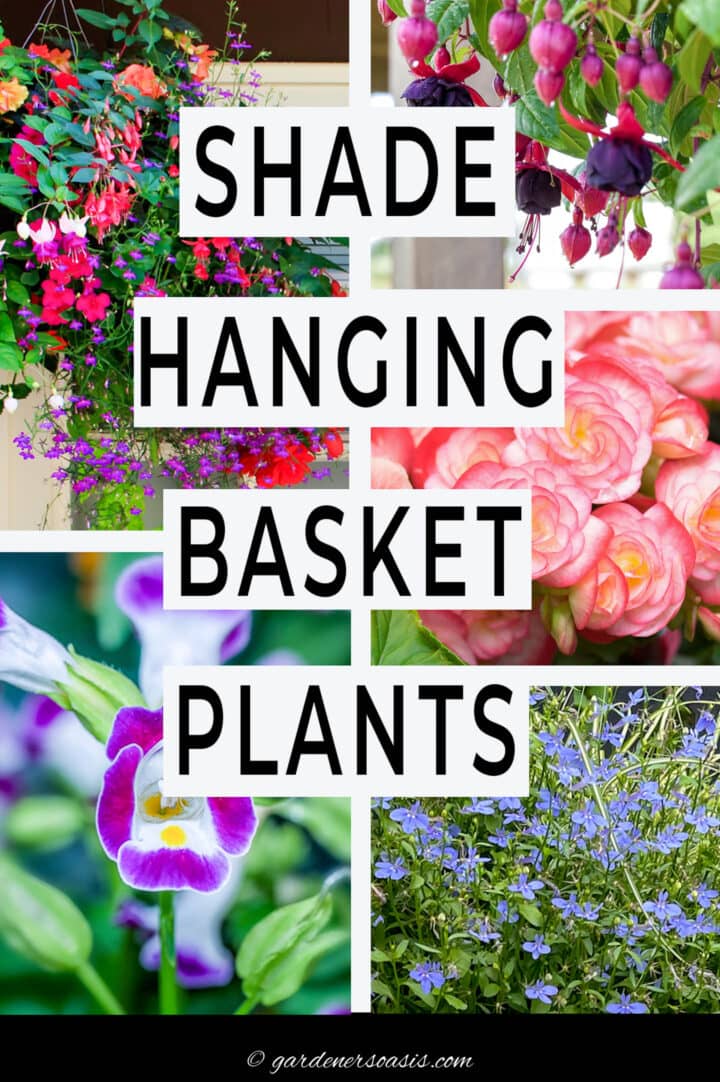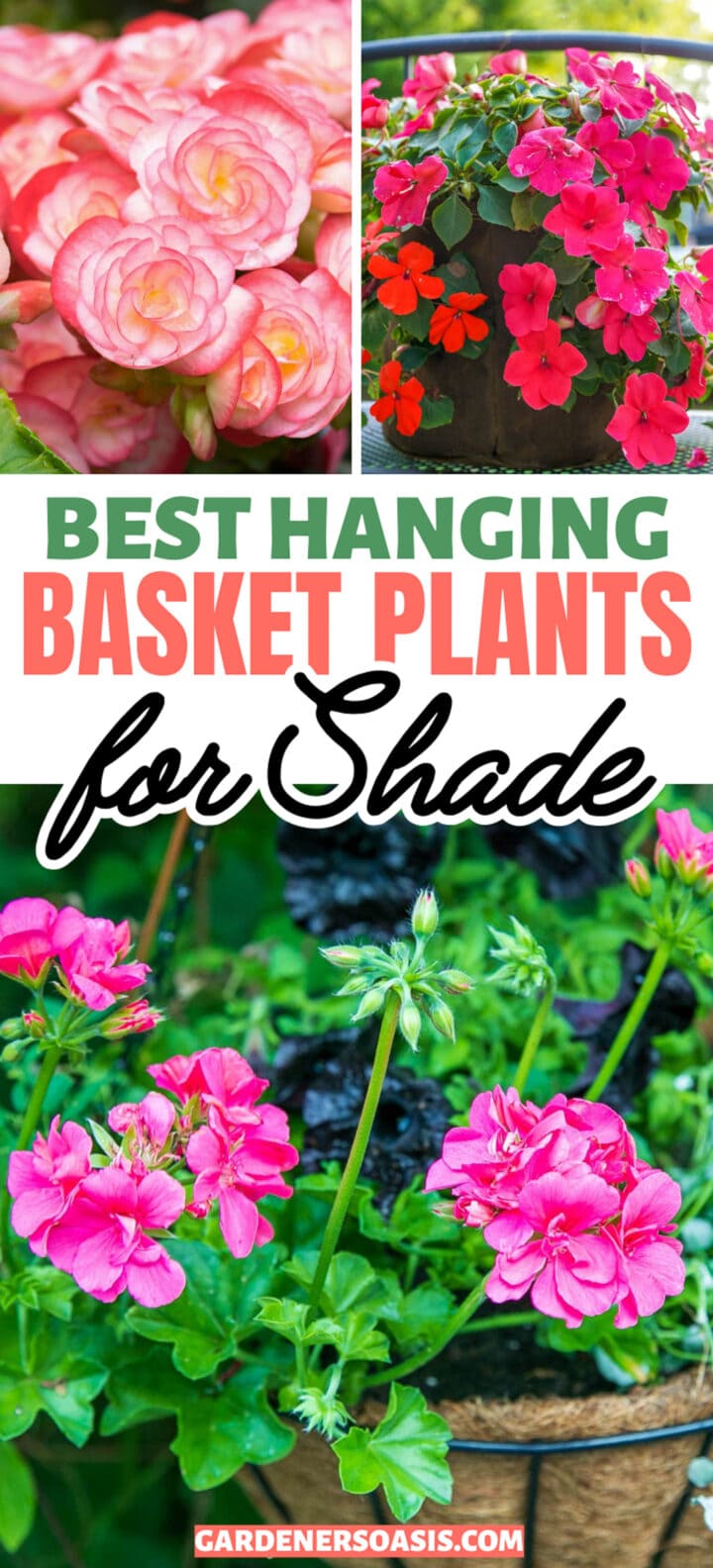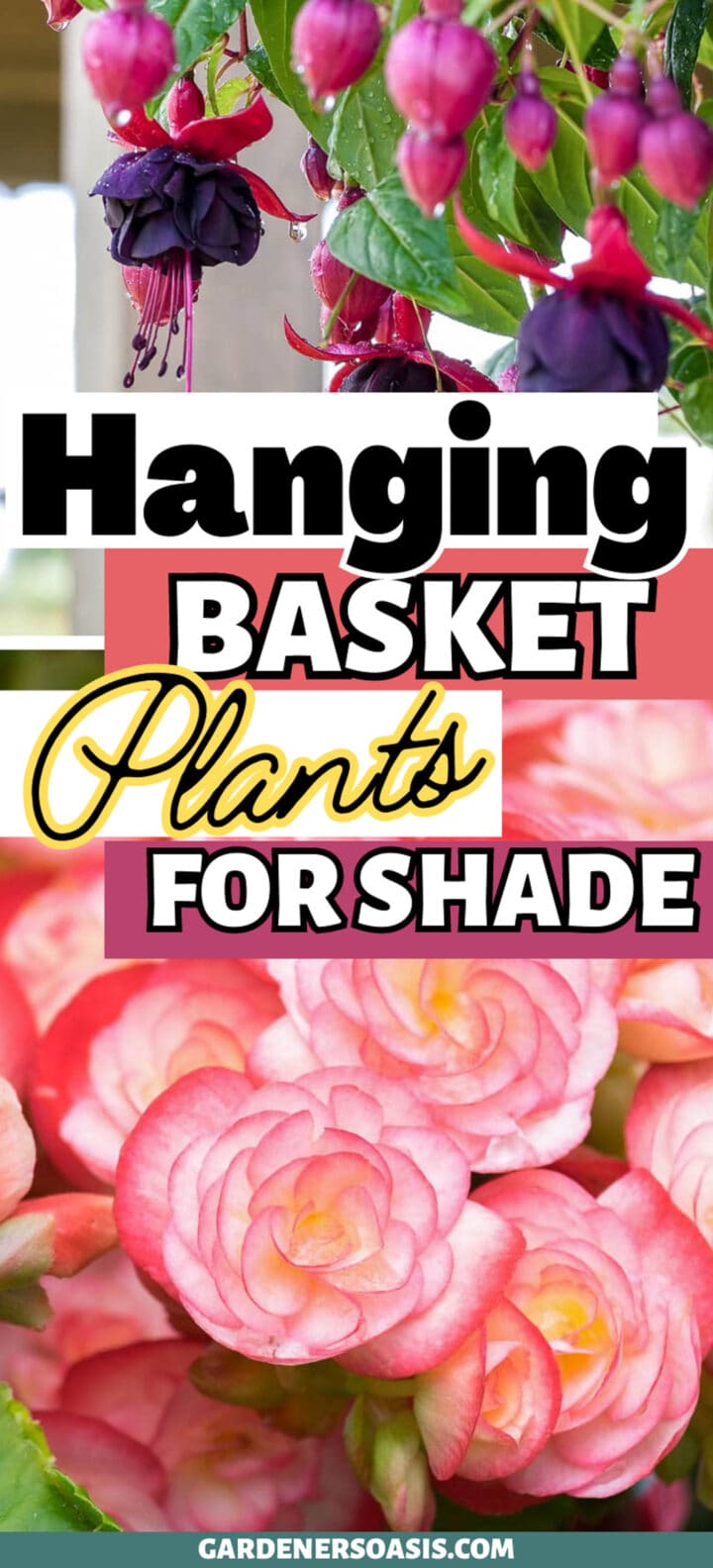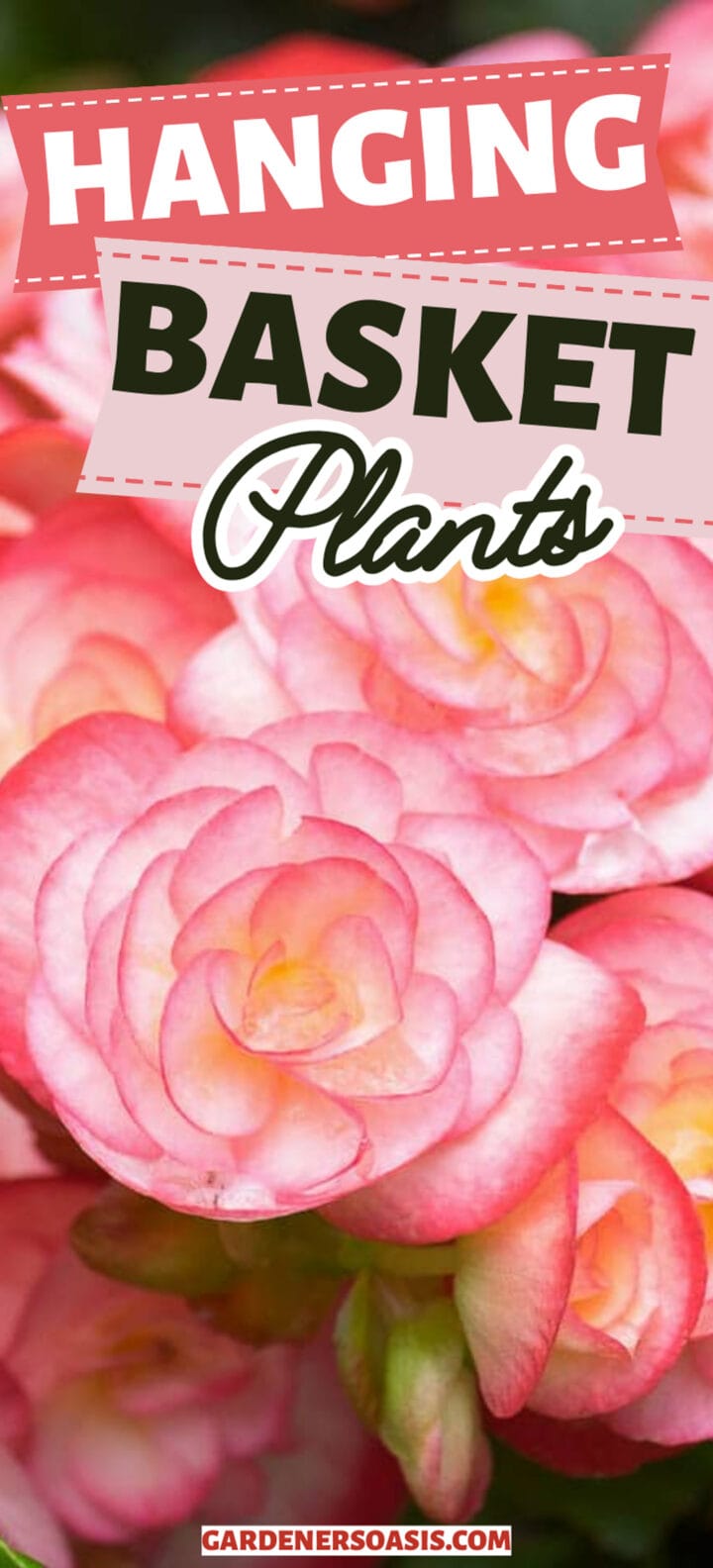Best Hanging Basket Plants For Shade
Whether you have a shaded porch needing a splash of color, or a north-facing balcony longing for some greenery, hanging baskets are a great way to liven up your space. This list of the best hanging basket plants for shade will give you lots of varieties to choose from.
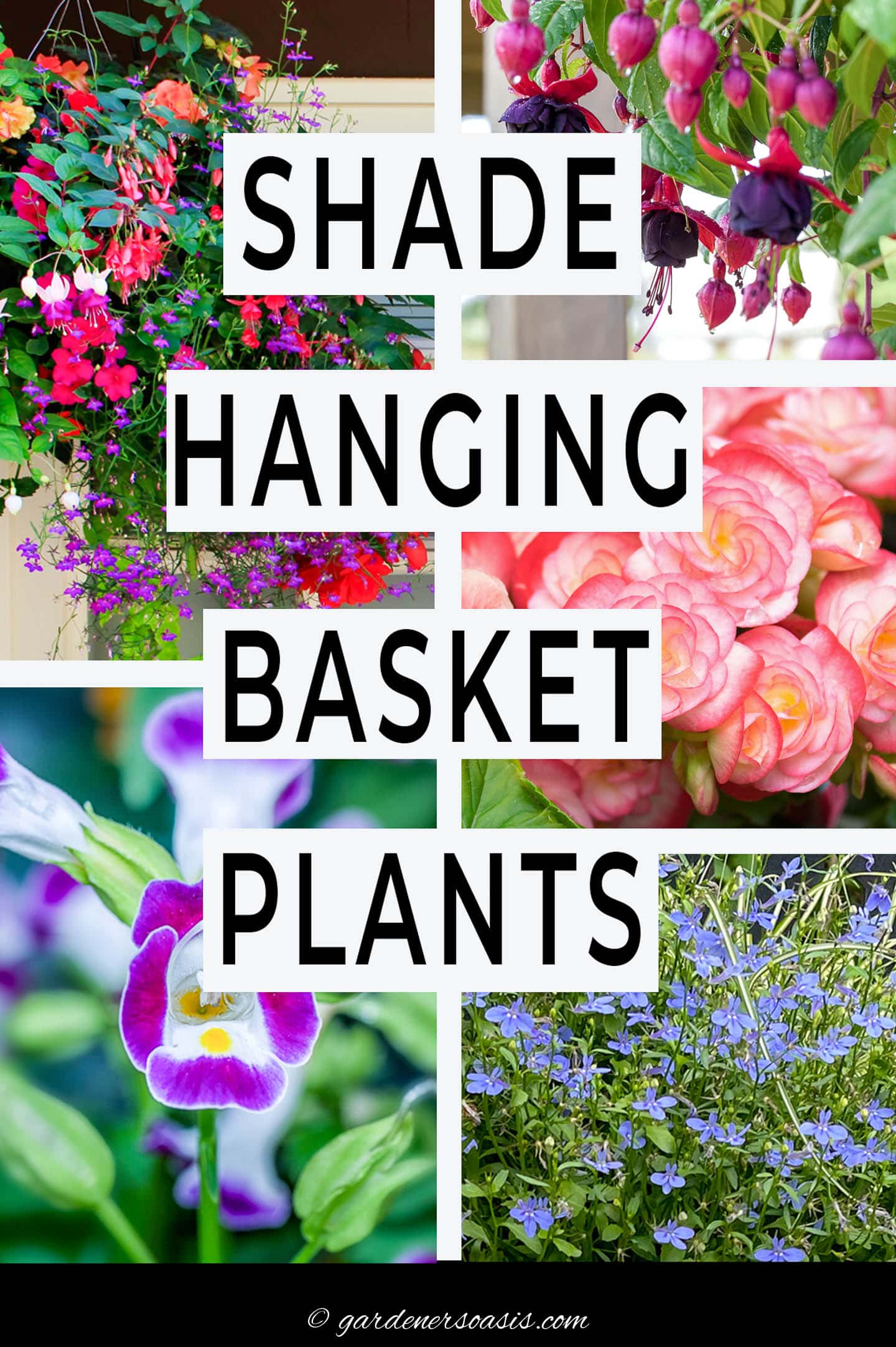
One of the most captivating ways to add life and color to a shaded corner, patio, or balcony is by installing hanging baskets filled with shade-loving plants.
But it can be tricky to find plants with plenty of blooms, beautiful foliage and a trailing habit that grow well in that location.
Since much of my yard is shady and I have quite a few hanging baskets, I have definitely faced this challenge over the years.
Which is where this list of plants comes from.
These are all of my favorite shade-loving plants that grow well in containers and don’t require a lot of maintenance.
1 | Boston Fern
This post may contain affiliate links. We make a small commission if you buy the products from these links (at no extra cost to you). As an Amazon Associate, I earn from qualifying purchases. But we only recommend products we would use ourselves. For more information, click here to see our disclosures.
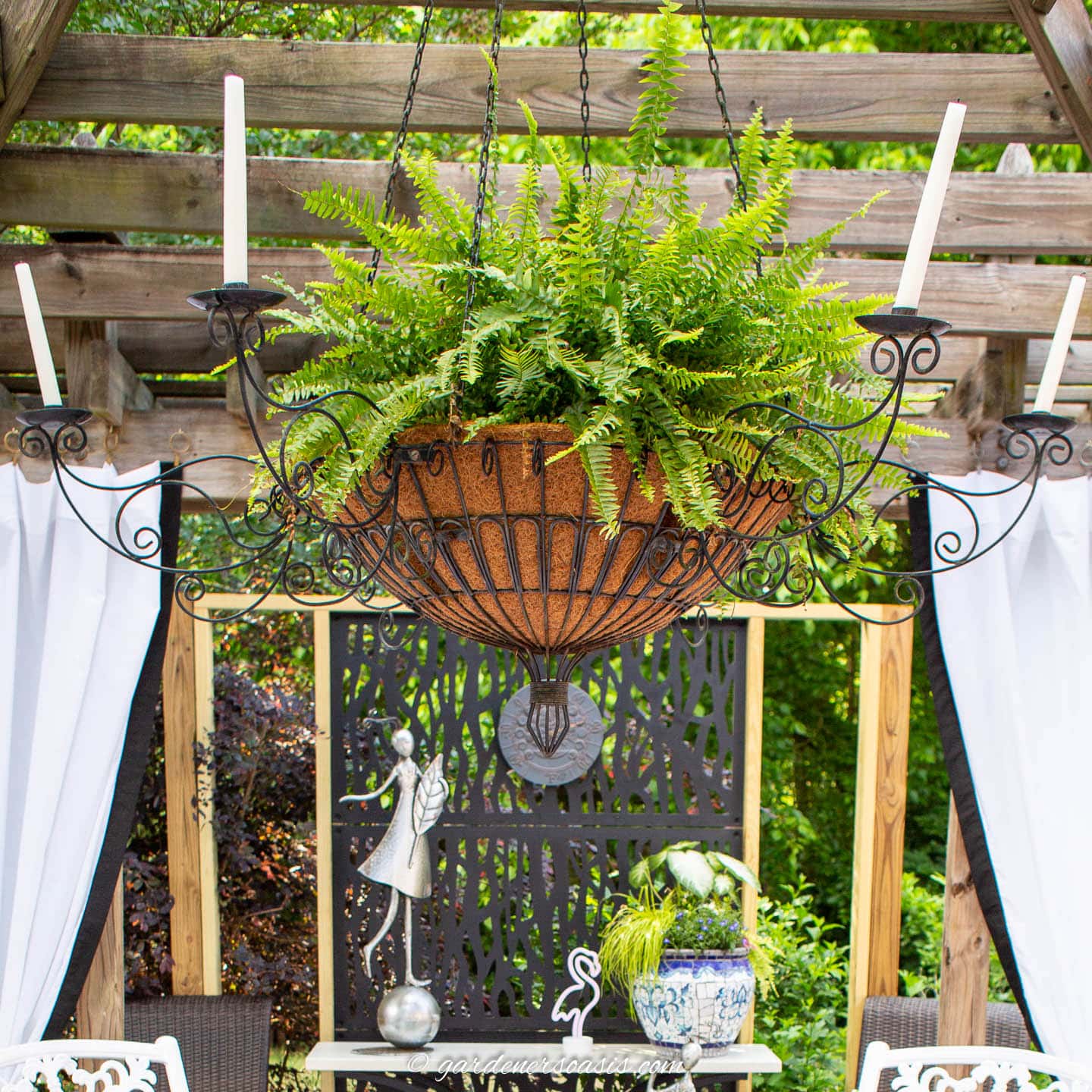
While Boston Fern does not bloom, this tender perennial is an elegant, shade-loving plant with lush, arching fronds that can fill a hanging basket.
These ferns prefer bright, indirect light and consistently moist soil.
They appreciate high humidity which is why you will often see them hanging from porches in the South.
If you live in a less humid environment, these plants benefit from regular misting.
While Boston ferns can make a statement all on their own, you can also pair them with Asparagus Fern, Impatiens, and Coleus to create a tropical, shade-loving arrangement.
2 | Fuchsia
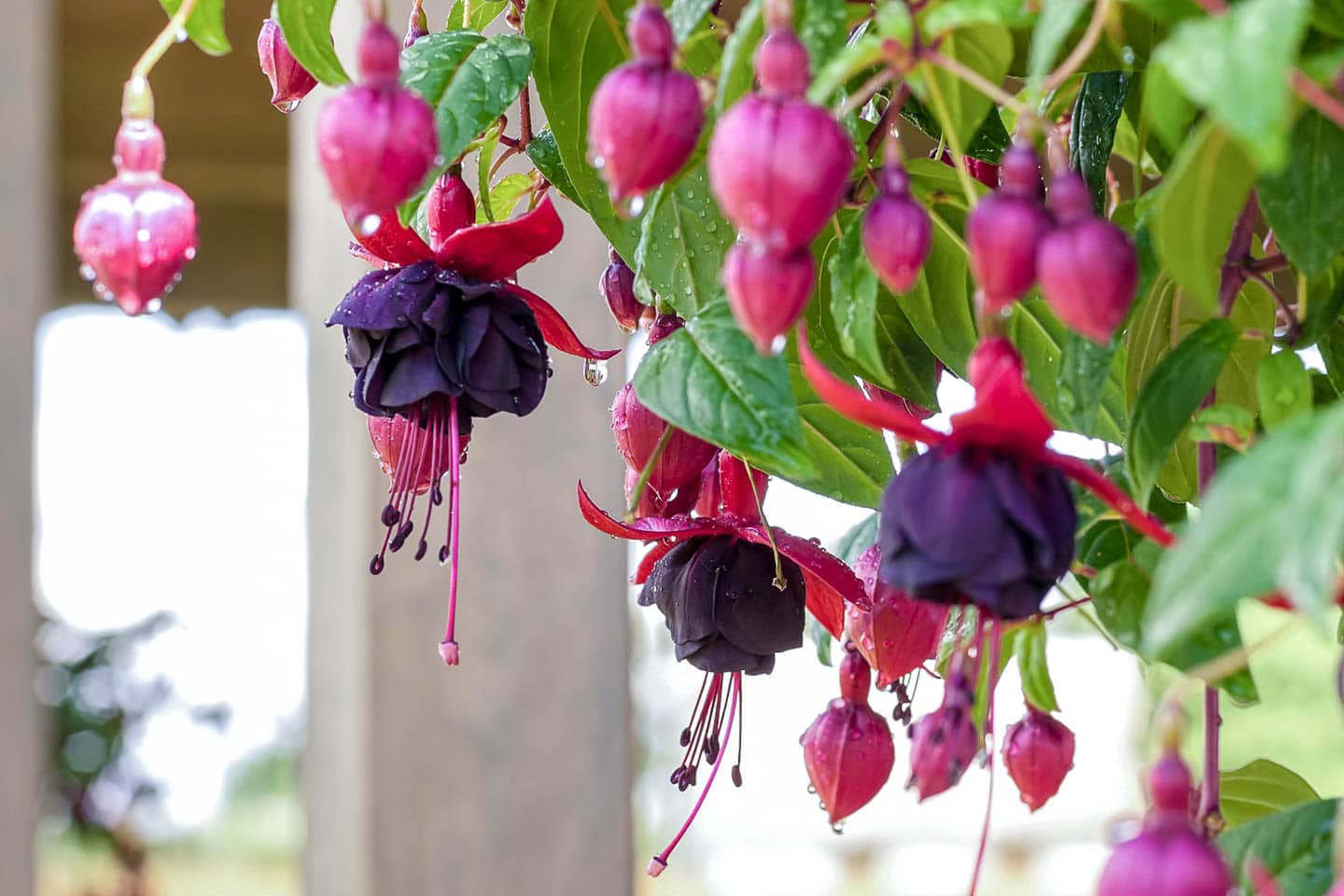
Fuchsia is a popular hanging basket choice for its stunning, drooping flowers and vibrant colors.
These exotic-looking flowers come in various shades of pink, purple, red and white.
Fuchsias prefer partial shade, consistent moisture and don’t like high heat or humidity.
They come in both trailing and upright varieties. So be sure to check the tags to get the variety you want.
These tender perennials also attract hummingbirds
3 | Trailing Geranium
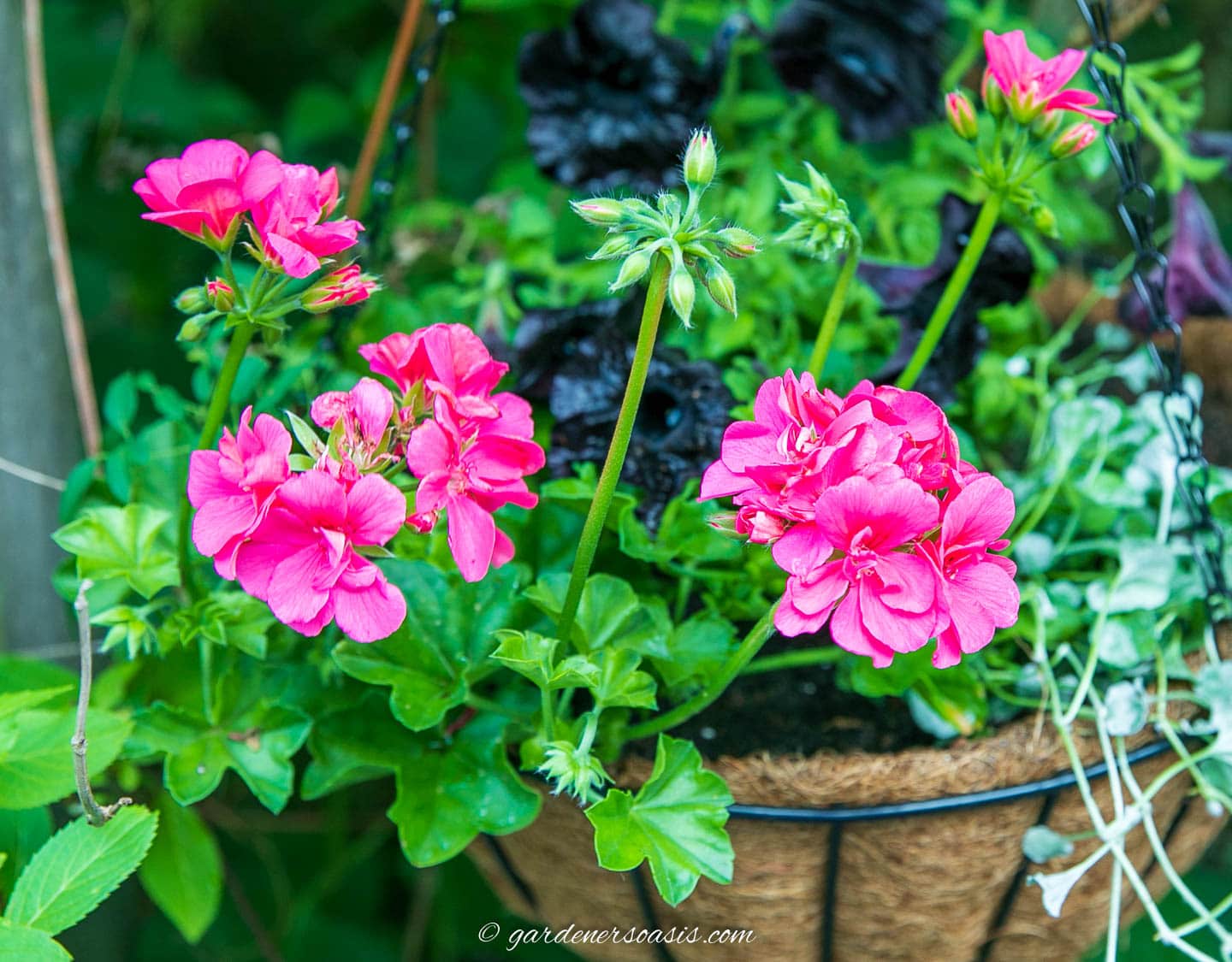
Trailing geranium is a popular plant with bright, showy flowers and a cascading growth habit that easily spills out of window boxes or hanging planters.
They come in a variety of colors, including red, pink, white, and purple.
These plants prefer partial shade, well-draining soil and consistent moisture, but don’t do well in high heat.
Pair with Lobelia, Nemesia, or Bacopa for a colorful, cascading effect.
4 | Caladium
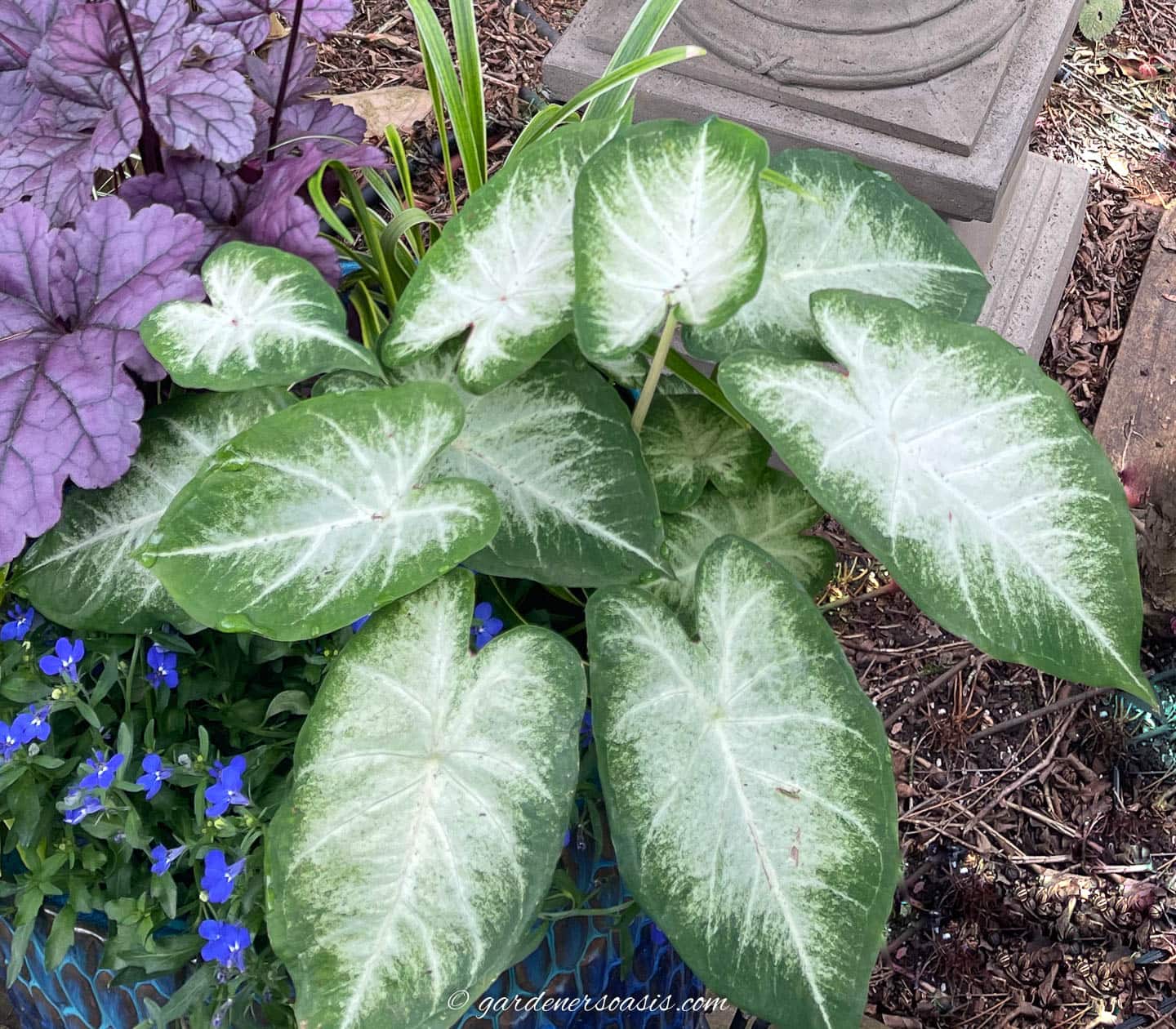
Caladium is a popular foliage plant known for its vibrant and intricately patterned leaves.
The leaves come in various shades of green, red, purple, orange, and yellow, often with contrasting veins or edges.
This plant prefers partial shade to shade, although some varieties can tolerate more sun and thrives in well-draining soil with consistent moisture.
During the growing season, pinch back the tips of the plant to encourage bushier growth.
Combine it with Heuchera, Impatiens, or ferns for a beautiful hanging basket that thrives in the shade.
5 | Lobelia
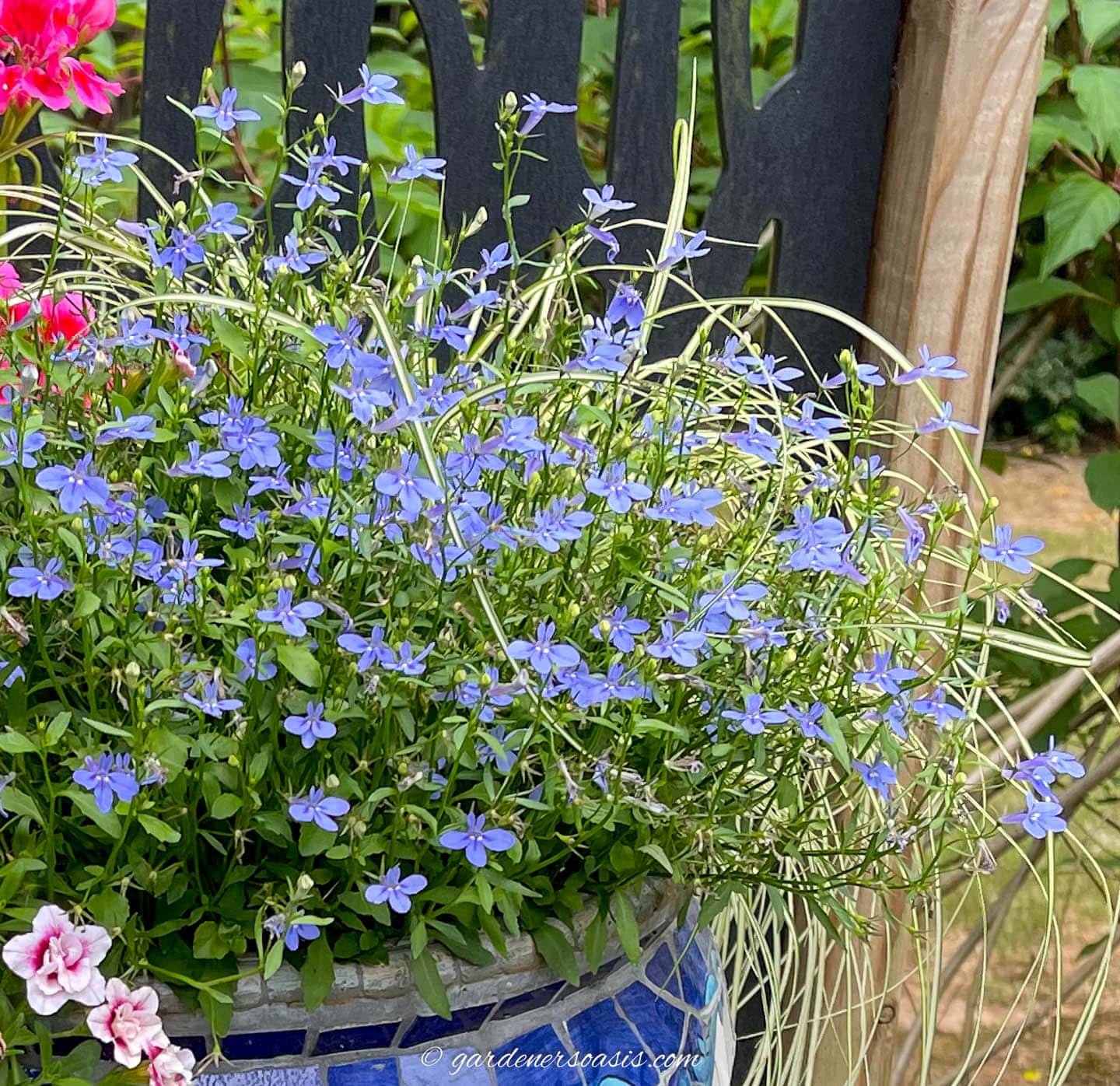
Lobelia is a versatile plant with small, delicate flowers in vibrant blue, purple, or white hues.
It is often listed as a sun plant, but I find that grows best in part shade to shade, especially in hotter climates.
This plant requires consistently moist soil and doesn’t do well in the heat. So if your summers are hot, you may need to replace it part way through the season.
Lobelia has both upright and trailing varieties. Make sure to check the tag to get the version you want.
Complement it with Ivy Geranium, Petunias, Calibrachoa and Sweet Potato Vine to create a multicolored, layered effect. I did this combination in a regular container, but it would look beautiful in a hanging basket as well.
6 | Begonias
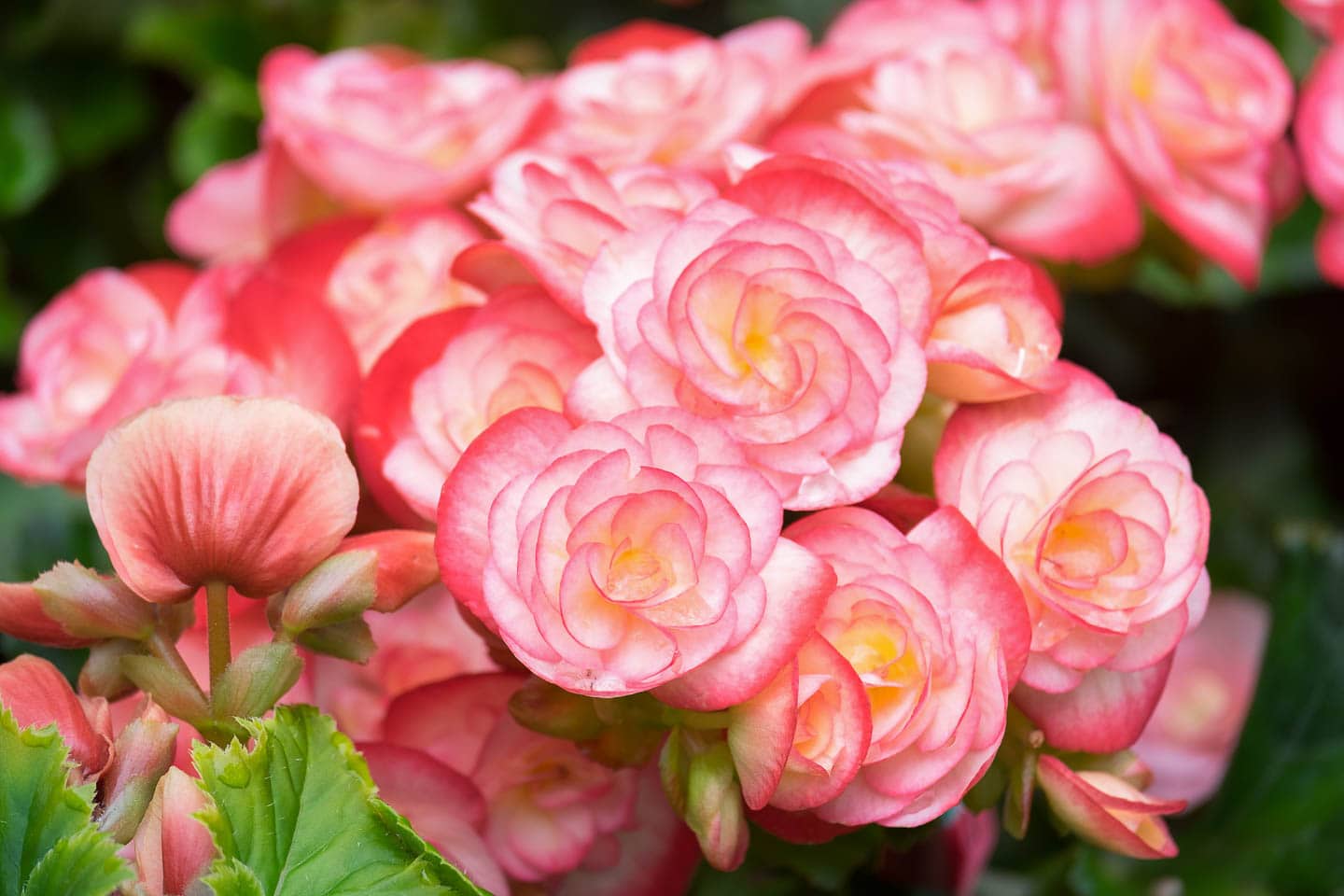
Begonias are known for their richly colored flowers and ornamental foliage.
These plants come in a variety of flower colors including red, white, pink, orange, yellow, and coral, as well as many interesting leaf colors.
Most types of begonia prefer part shade to shade, well-draining soil and consistent moisture. But there are many types that grow best in different conditions so be sure to check the labels when you’re buying them.
7 | Coral Bells
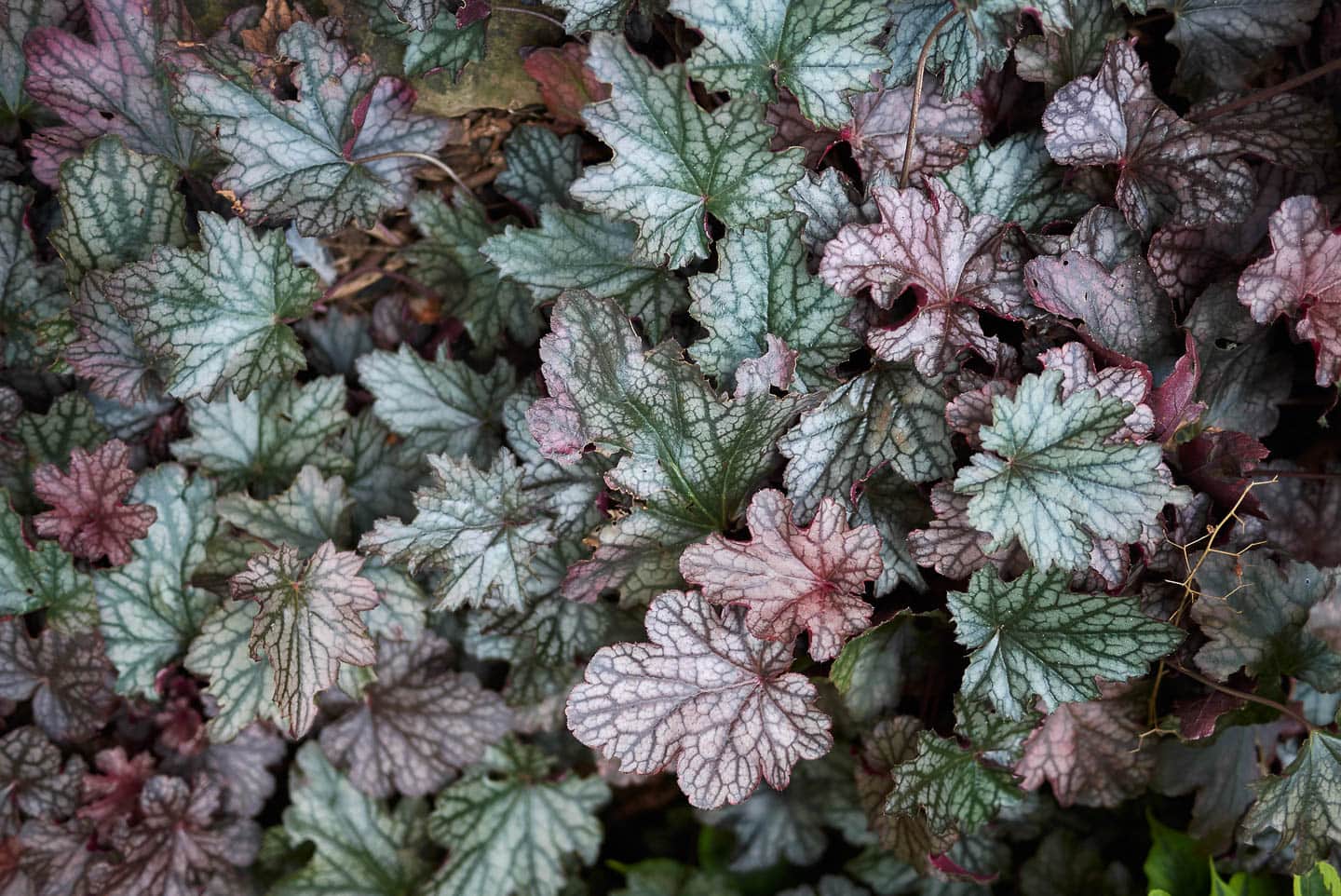
Known for their vibrant and diverse foliage, Coral Bells (also known as Heucheras) are a great addition to any shade hanging basket.
While they do produce small, bell-shaped flowers on long stems in late spring, the main appeal of this perennial is its beautiful foliage.
The leaves come in a wide variety of colors, from deep purples to bright lime greens, making them a versatile option for any color scheme.
They’re a perennial plant in many zones, but don’t always survive the winter in containers. So I like to find a spot to plant them in the garden at the end of the season.
8 | Dichondra
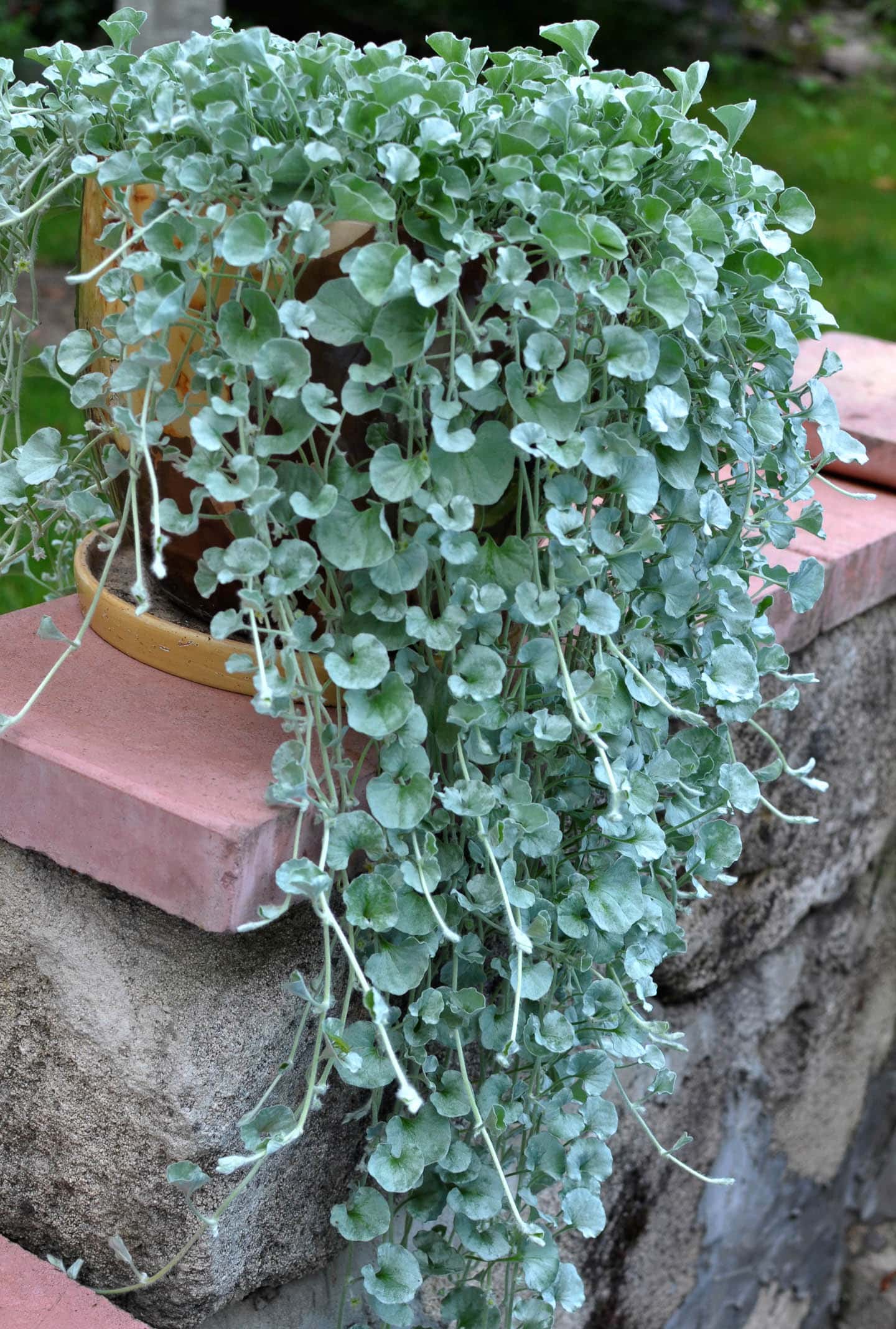
Dichondra is a trailing plant with small coin-shaped leaves that creates a stunning cascading effect in hanging baskets.
It can be combined with most other plants to add a vertical element to the planter.
While it does bloom, the flowers are very small and insignificant. So it is mostly grown for its foliage.
The “Silver Falls” variety is my favorite because of the beautiful silver leaves.
9 | Impatiens
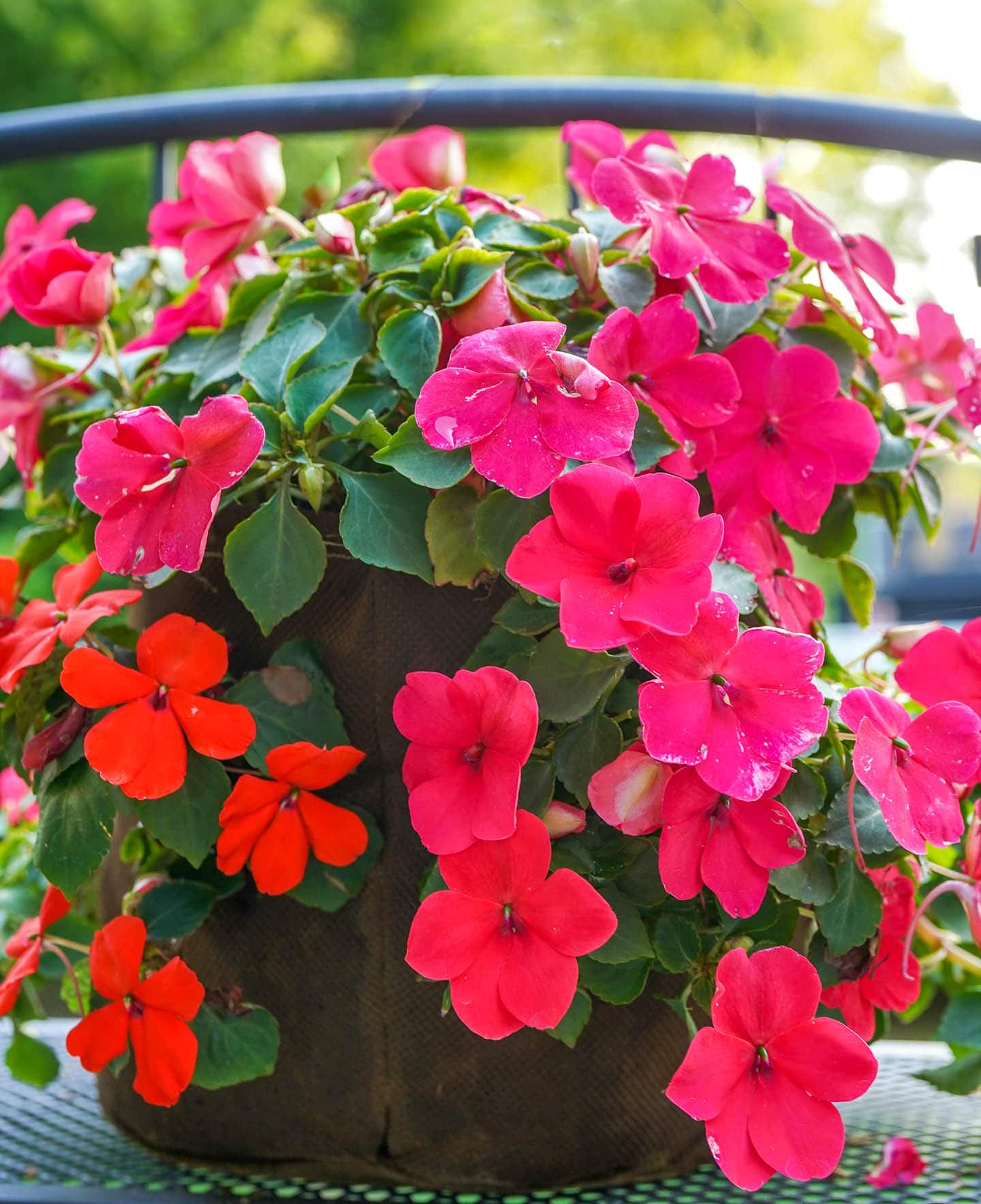
Impatiens are one of the best blooming plants for shade containers and hanging baskets.
They provide a mass of color throughout the summer, and only require regularly watering to do so. No deadheading needed!
Although most people think of Impatiens as strictly shade plants, there are some varieties that grow in the sun. So check the light requirement on the tag to make sure you are getting the ones you want.
10 | Streptocarpella
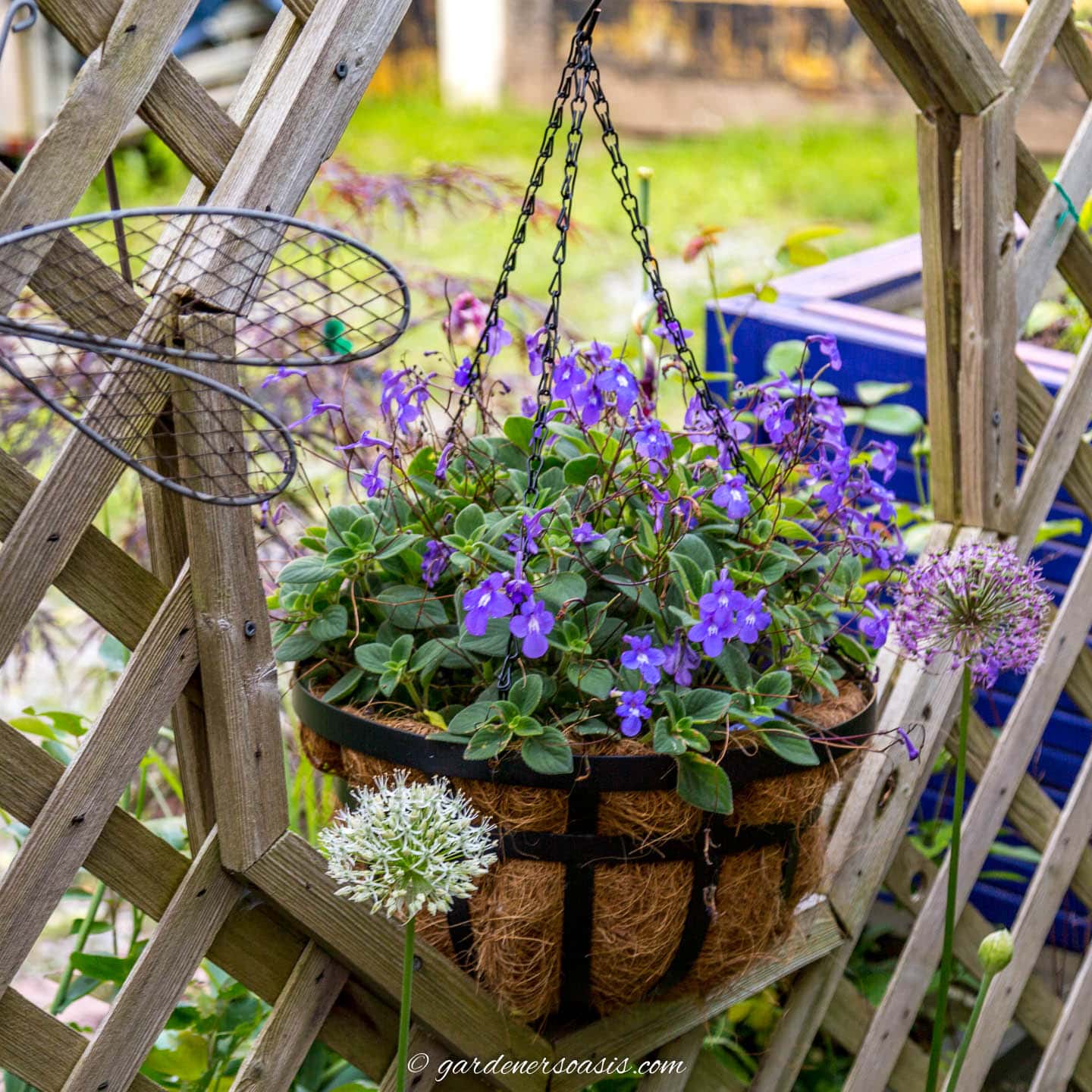
Often referred to as False African Violet, Streptocarpella is a trailing plant that blooms almost continuously in the shade. Which makes it perfect for a shady hanging basket.
It is characterized by soft, green, slightly fuzzy foliage and delicate, tubular blue or violet flowers.
This plant is a relative of the African Violet and has similar care needs. It prefers well-draining soil and likes to dry out slightly between waterings.
11 | Sweet Potato Vine
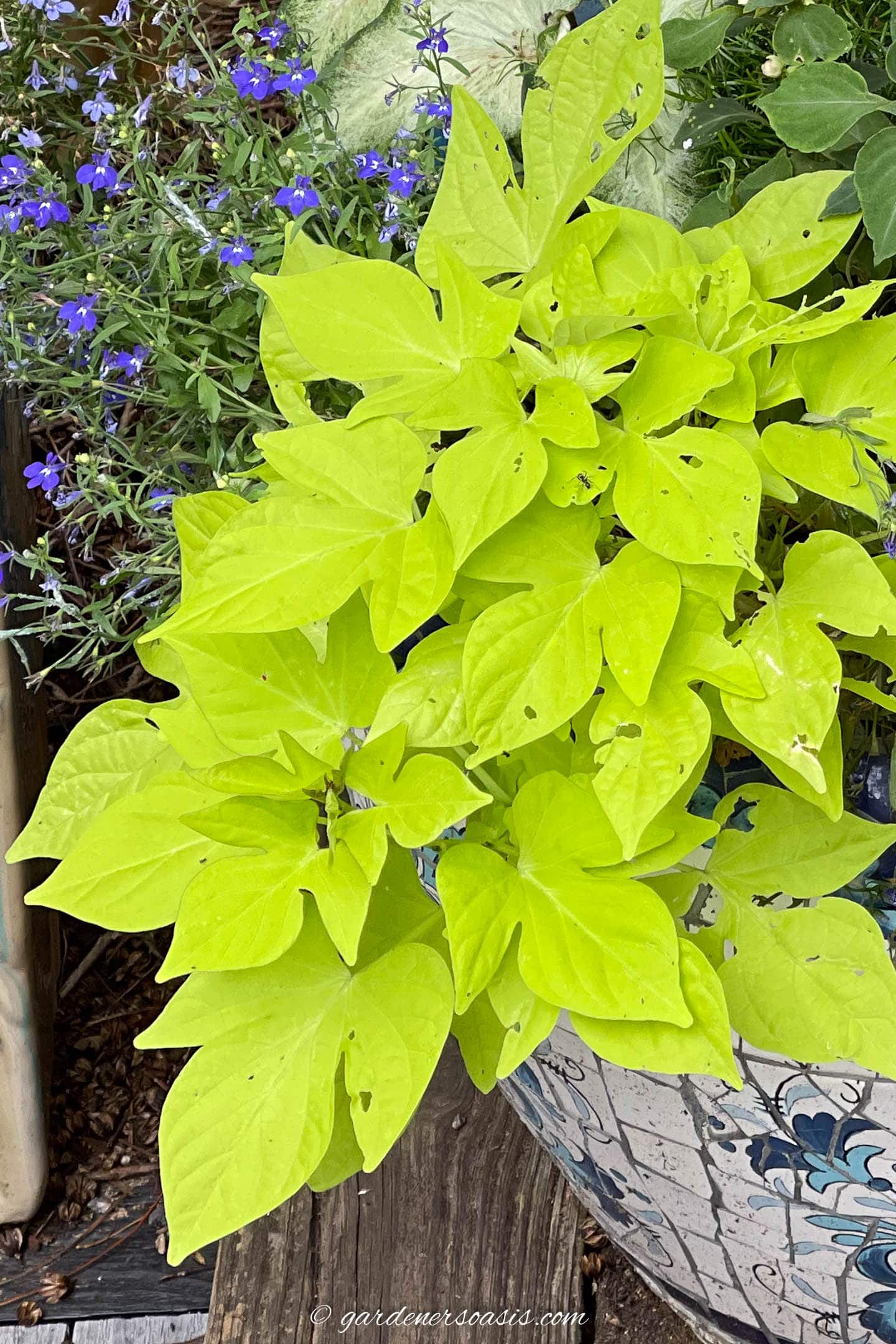
Sweet potato vine is a popular plant for hanging baskets, thanks to its fast growth and vibrant foliage. Which is available in a variety of colors, including bright green, dark purple, and even tri-color varieties.
I like to use them as “spillers” in all kinds of container arrangements because they quickly fill in spaces and easily trail over the sides.
In fact, they grow so fast, you may need to give them a trim once in a while to keep them at your desired length.
12 | English Ivy
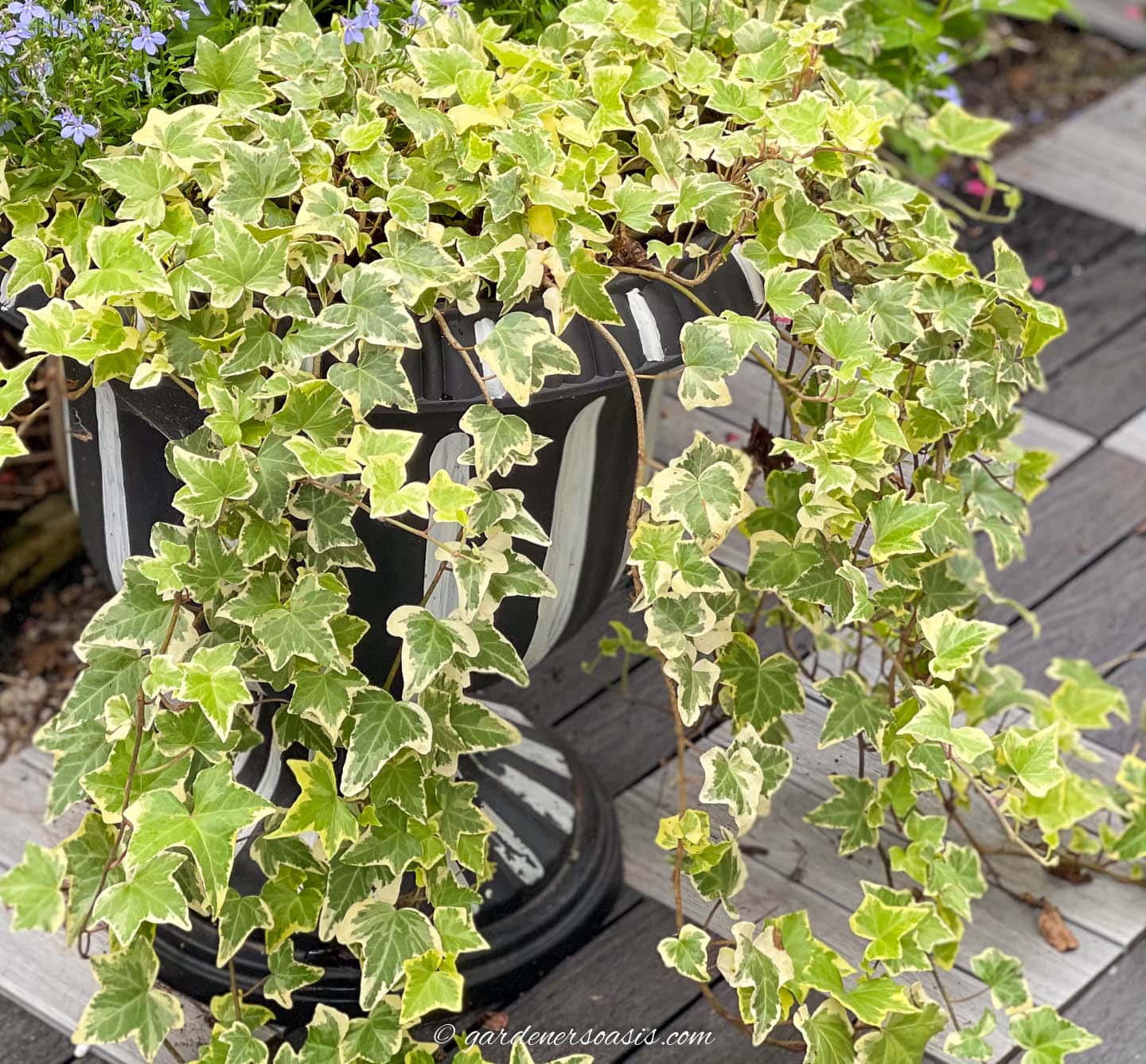
English ivy is another great choice for a foliage-only plant.
It’s easy to grow and provides a nice, trailing greenery effect.
To add even more interest to your hanging baskets, look for varieties with variegated leaves.
Ivy can be invasive if allowed to escape from the container, so I like to keep it trimmed. This makes sure it doesn’t have a chance to touch the ground and start growing where I don’t want it.
13 | Creeping Jenny
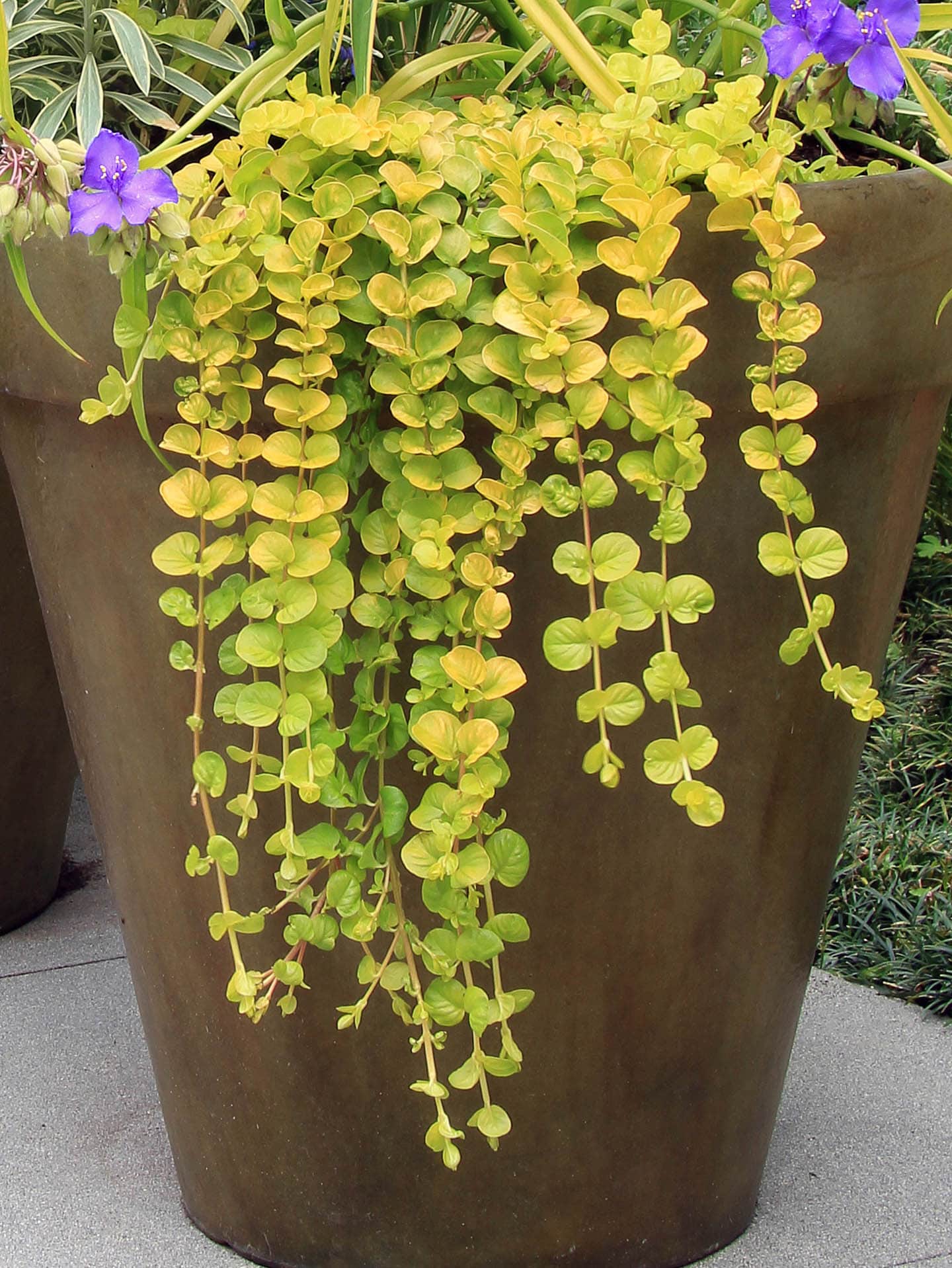
Creeping Jenny is a perennial ground cover that is often used in hanging baskets due to its lovely trailing habit.
Its round, slightly ruffled leaves are a bright, light green, often providing a beautiful contrast to darker foliage or brightly colored flowers.
This plant is fast-growing and can quickly provide a trailing element to any hanging basket.
It prefers consistently moist soil, so regular watering is important.
Creeping Jenny is invasive in some areas, so I trim it when it starts to get too long to make sure that it doesn’t escape the container.
14 | Torenia
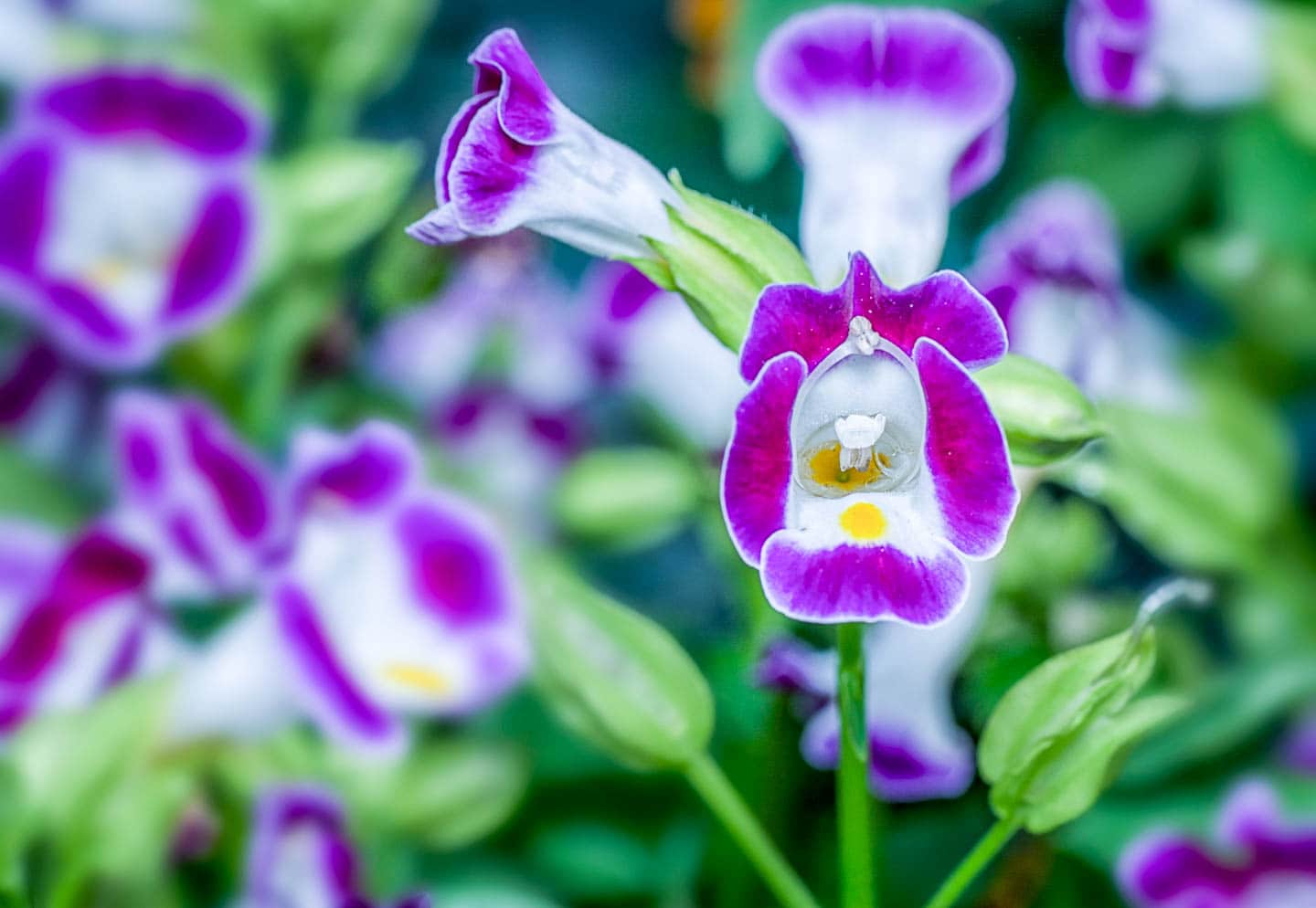
Often referred to as the Wishbone Flower, Torenia is a charming plant perfect for shady areas.
It’s a small, bushy annual that typically grows 6-12 inches tall.
This plant produces an abundance of trumpet-shaped, blue or purple flowers throughout the summer and well into the fall.
It performs well in hanging baskets thanks to its semi-trailing habit.
Torenia prefers well-drained, fertile, and consistently moist soil. It’s important not to let the soil dry out completely, but also to avoid waterlogged conditions as this can lead to root rot.
15 | Calibrachoa
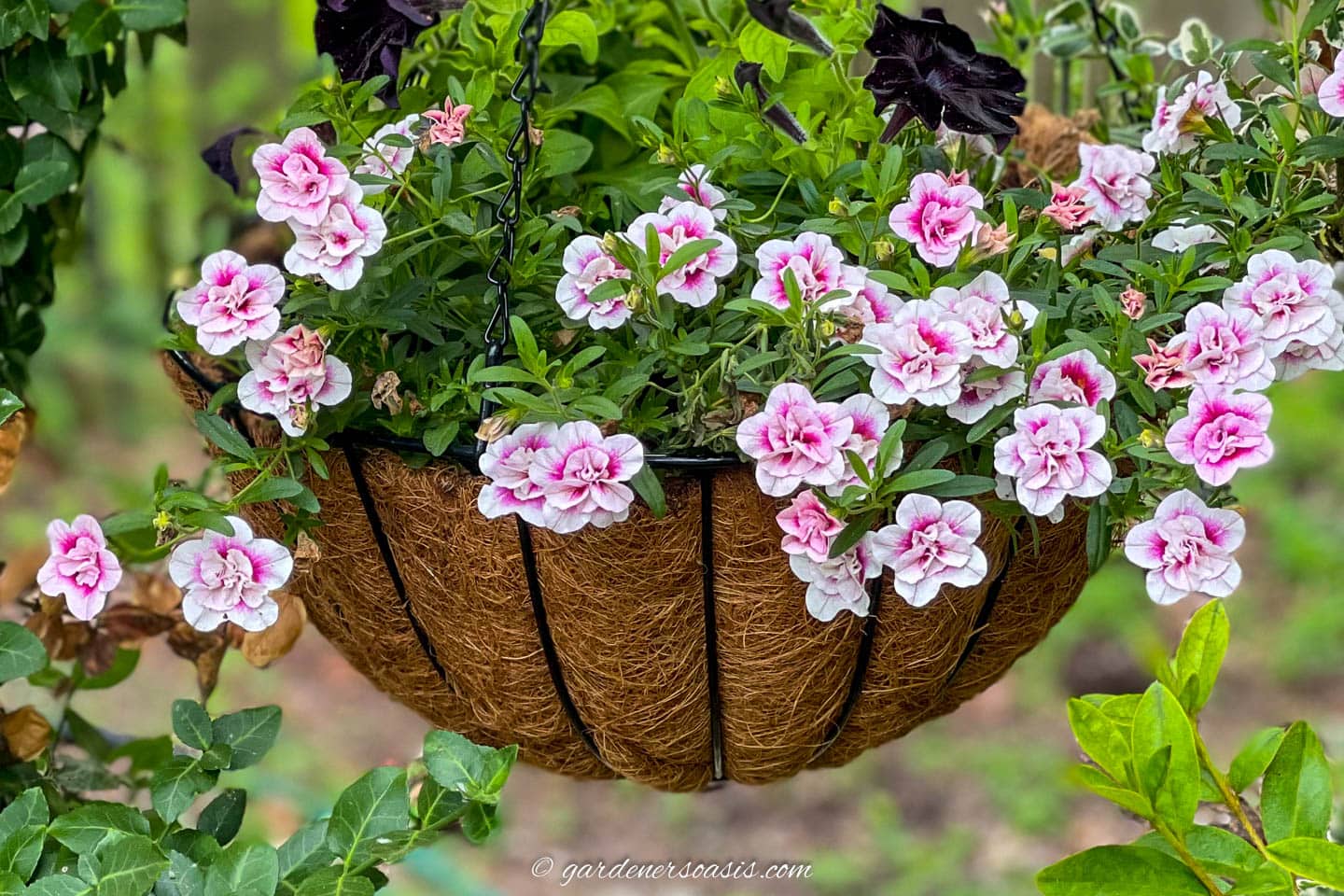
Known commonly as “Million Bells,” Calibrachoa is a delightful plant popular for its abundant, small flowers that often resemble miniature petunias.
It blooms throughout the summer and comes in a vast array of colors including blue, pink, red, yellow, white, and multicolored varieties.
This plant is often used in hanging baskets due to its semi-trailing habit. The profusion of flowers and the way the plant spills over the edge of a basket make for a stunning display.
While this is more of a part shade plant than full shade, it makes such a show that I couldn’t leave it off the list.
The plant prefers well-drained soil and does not like to be overly waterlogged. Regular watering is important, but allow the top layer of soil to dry out between waterings to prevent root rot.
Feeding regularly with a balanced liquid fertilizer during the growing season will help promote continuous blooming.
Calibrachoa is usually grown as an annual, but it has come back in my zone 7b garden in upstate South Carolina. And can be overwintered indoors in colder climates.
hanging basket plant combinations for shade
Now that you’ve seen the list of plants, here are some hanging basket plant pictures and recipes to show you how to use them in combination.
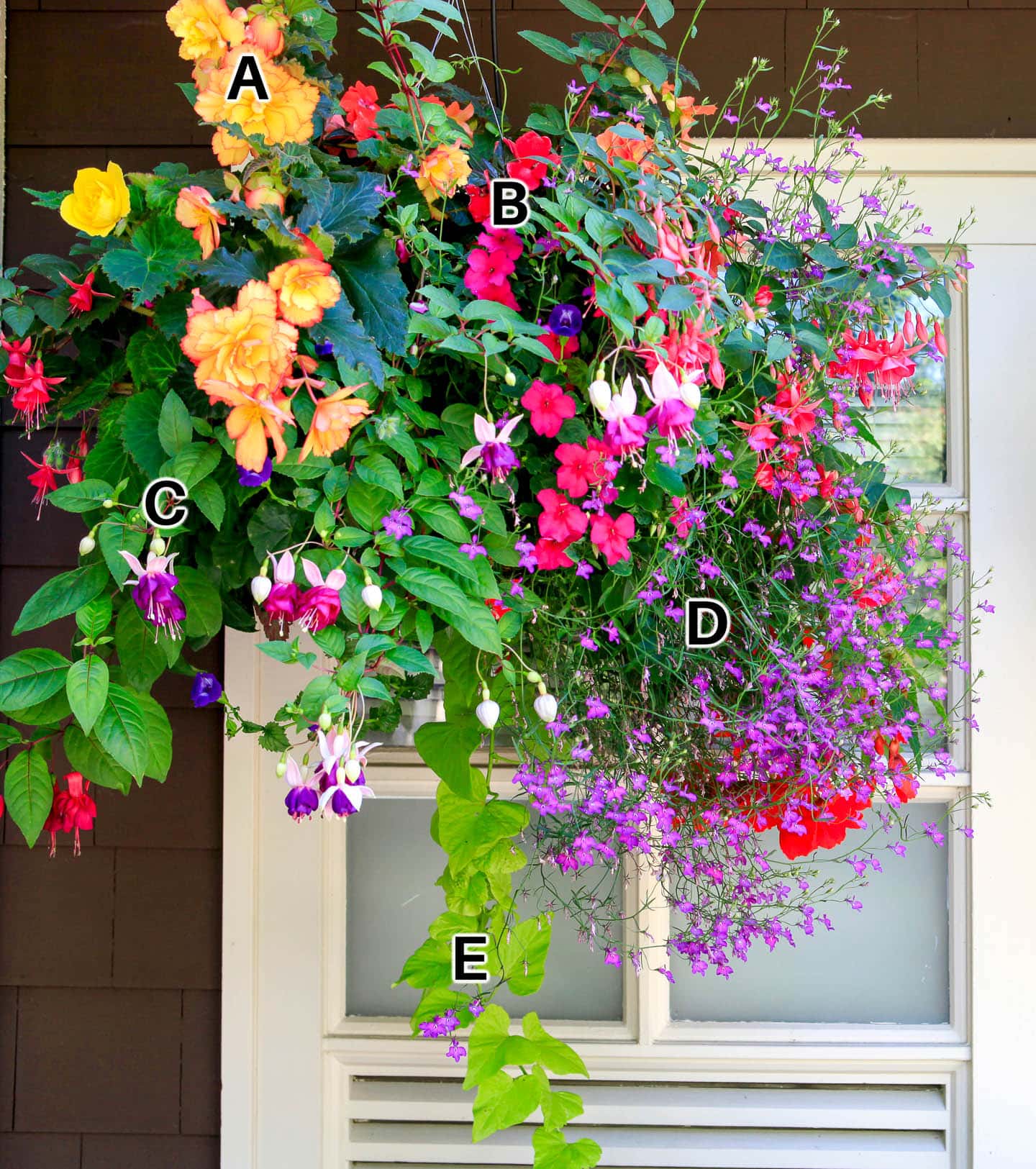
A – Begonias
B – Impatiens
C – Fuchsia
D – Lobelia
E – Sweet potato vine
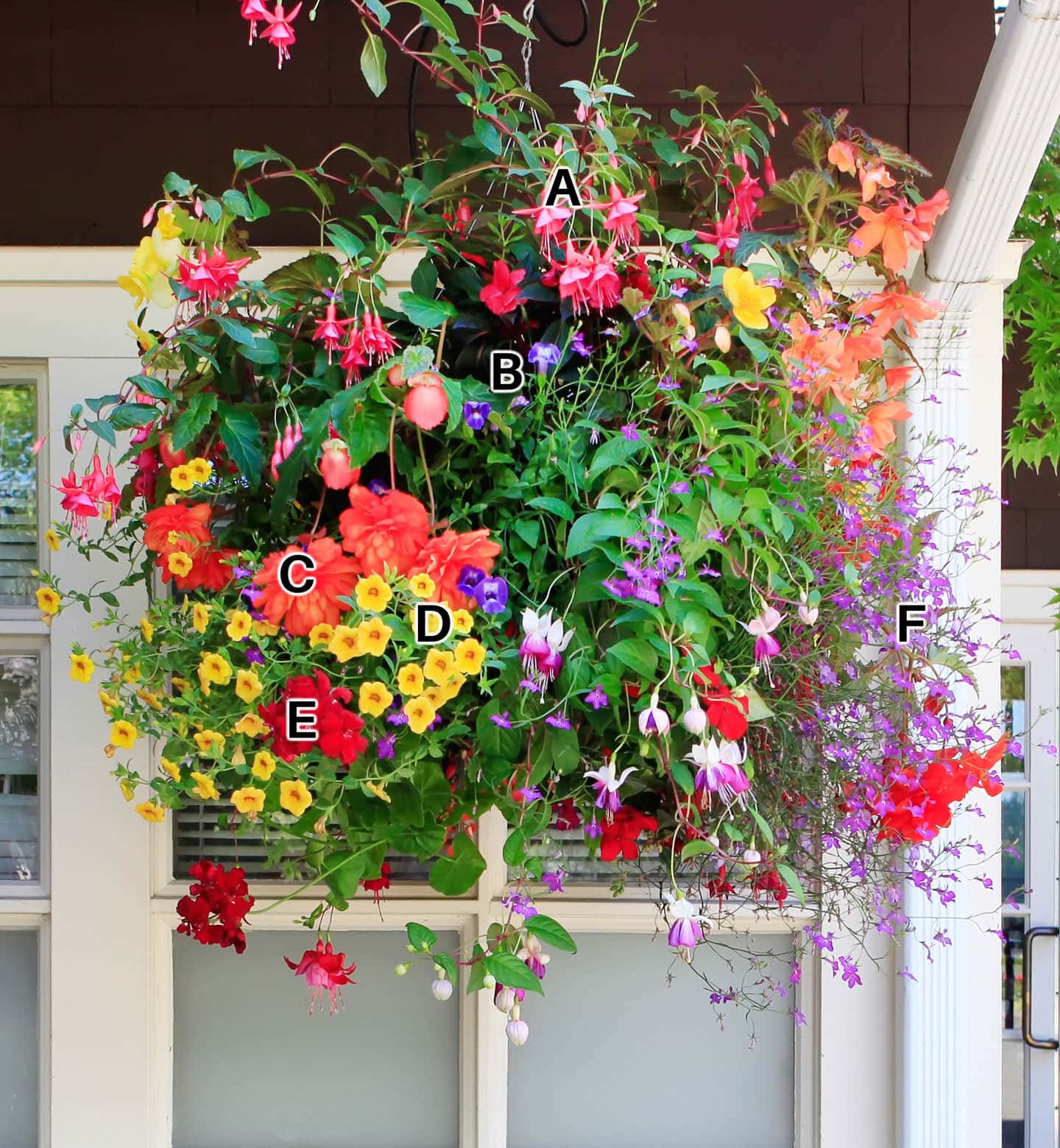
A – Fuchsia
B – Torenia
C – Begonia
D – Calibrachoa
E – Trailing Geranium
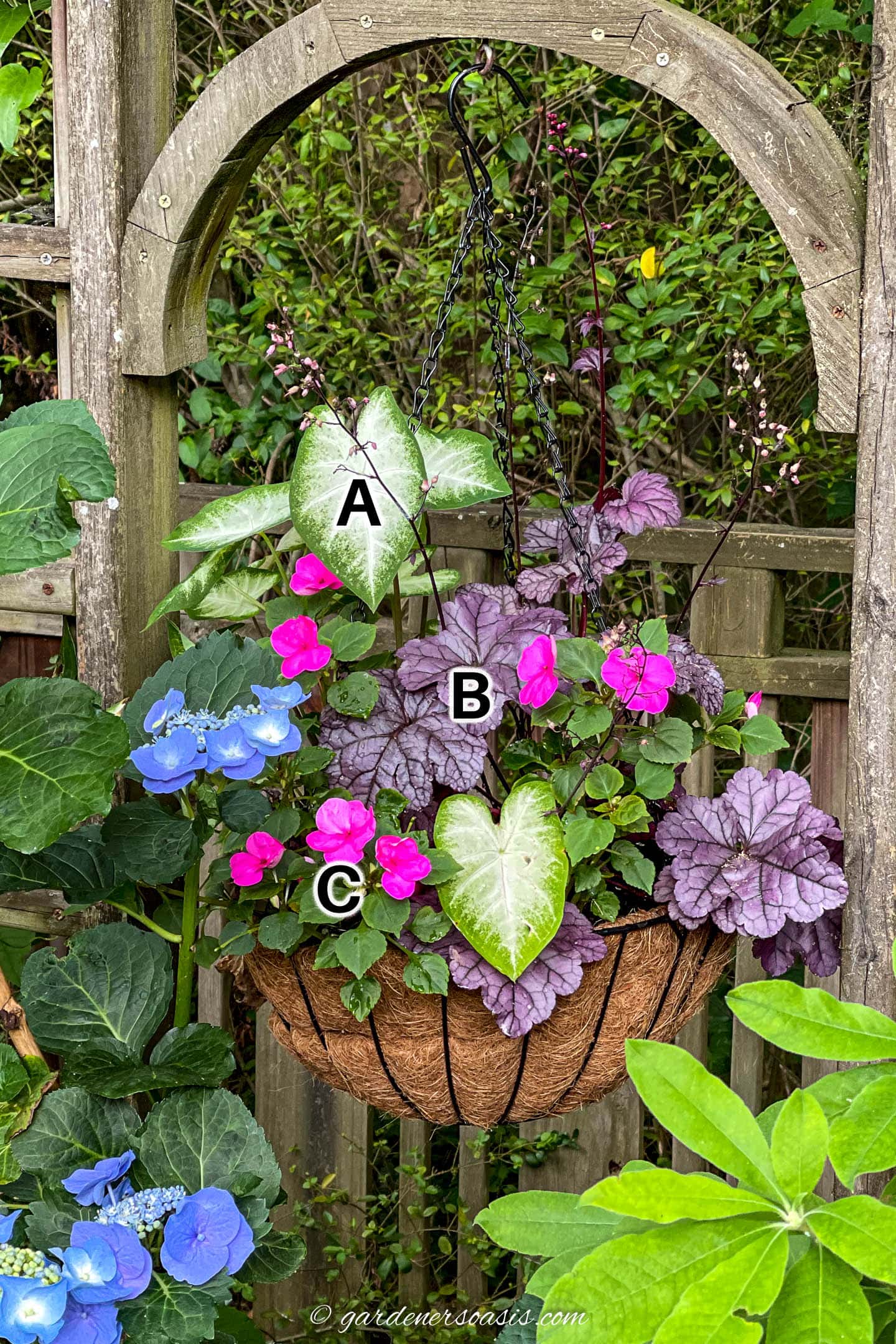
A – Caladium
B – Coral Bells
C – Impatiens
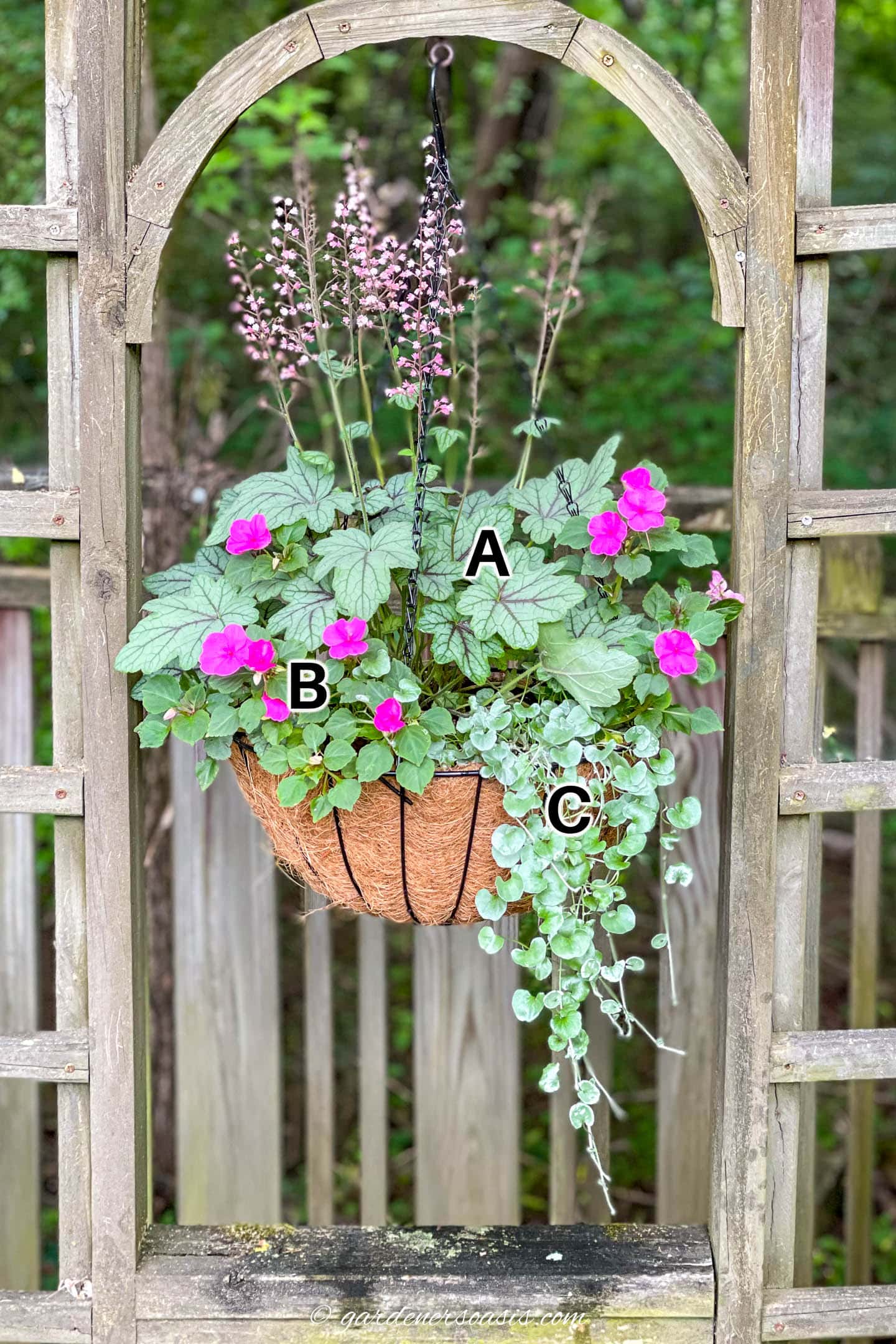
A – Coral Bells
B – Impatiens
C – Dichondra
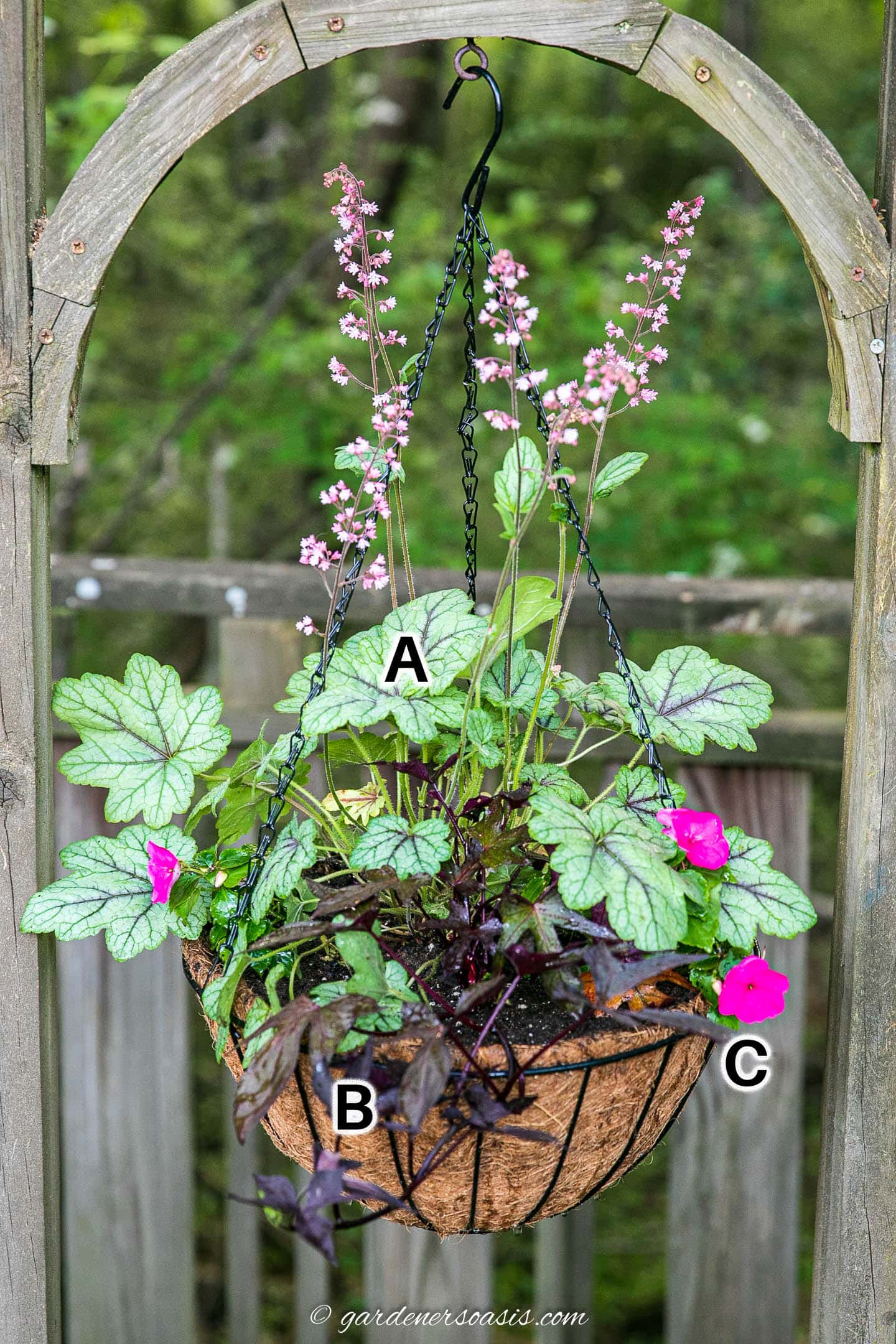
A – Coral Bells
B – Sweet Potato Vine
C – Impatiens
Frequently Asked Questions
What are the best trailing plants for hanging baskets in the shade?
The best trailing plants for shade are Dichondra, Sweet Potato Vine, Creeping Jenny, Fuchsia, Lobelia, Calibrachoa and English Ivy.
How often should I water my hanging basket plants in the shade?
The frequency of watering will depend on the type of plant, the size of the hanging basket, the material of the basket, and the climate. As a general rule, check the soil regularly and water when the top inch feels dry to the touch.
Do hanging basket plants in the shade need fertilizer?
Most plants benefit from occasional feeding, especially during the growing season. Use a suitable plant food and follow the package instructions.
Can hanging basket plants be overwintered?
Some hanging basket plants can be overwintered indoors or in a greenhouse, depending on the specific plant and the local climate. Others are grown as annuals and will need to be replaced each year.
In conclusion, creating a stunning display with hanging basket plants for shade can be an exciting and rewarding endeavor.
There’s an impressive number of plant varieties that thrive in less sunny spots, each offering its own unique appeal, whether it’s vibrant flowers, intriguing foliage, or a trailing growth habit.
By carefully selecting and caring for your shade-loving hanging basket plants, you can transform your shady areas into vibrant, living displays of color and texture.
Other container gardening posts you might like
- Best blue annuals for shade
- How to plant a hanging basket
- How to keep outdoor planters watered (automatically)
- Window box flower combinations
Or browse all of our container gardening ideas.
Have comments or questions about our hanging basket plants for shade? Tell us in the section below.
This post was originally published on May 9, 2023 but was updated with new content on February 16, 2024.
